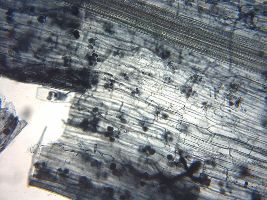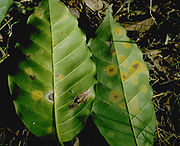Interactions and Adaptations
Coffee is not the only plant producing caffeine. There
are actually 80 different plant species that produce caffeine
which may aid in their protection and survival. This “poison”
produced by the plants gives it a harsh taste, deterring
predators. The organisms that feed on the plant learn to stay
away as it can cause harm to the consumer’s central nervous
system as well as harmful side effects including death. Some
insects are able to withstand the caffeine intake and can ruin
crops that have large infestations of insects. Therefore, coffee
is the heaviest sprayed good.
intake and can ruin
crops that have large infestations of insects. Therefore, coffee
is the heaviest sprayed good.
Caffeine also provides protection under the soil, protecting the plant from bacteria and fungi. The drug spreads throughout the soil killing these harmful pests and may even keep down the weeds around the plant fighting for its nutrients.
 Arbuscular mycorrhizal fungi from the phylum Glomermycota are in
association with the coffee roots. This type of fungi typically
is involved in a mutualistic relationship aiding the overall
production of the plant by increasing its nutrient intake and
getting sugars in return from the photosynthesis of the plant.
Arbuscular mycorrhizal fungi from the phylum Glomermycota are in
association with the coffee roots. This type of fungi typically
is involved in a mutualistic relationship aiding the overall
production of the plant by increasing its nutrient intake and
getting sugars in return from the photosynthesis of the plant.
Filamentous fungi, yeast, and bacteria have also been found during the wet method of processing the beans affecting the quality of the coffee but it is not known to what extent. Bacteria are commonly found in highest numbers when the berries are still on the tree, but also during some steps of fermentation processes where yeasts are also found. Filamentous fungi are mostly found at the end of drying and fermentation and in very low amounts when the berries are still on the tree. (Click here to see these processes)
Canopy trees were originally need to provide the plant with some
amount of shade, but were high enough that the coffee received
the moderate amount of sun required for maximum production.
The trees growing between these two necessary layers,
however, needed to be taken out. 
Instead of being naturally pollinated by just the source
of wind, bee-mediated pollination has been experimentally shown
to increase production.
Bees have not only helped increase
pollination but also in the quality of the fruit yielding an
increase in overall revenue for the farmers shown from small
studies done in
Other than insect destruction there are diseases that can affect the production of the crop.
Coffee Rust became known in
Coffee berry disease was first discovered in
Bacterial blight is present when conditions of climate are cold
and wet. Blight in this case is not preventable, and is not a
very common disease of the plant.

Pests are not complete without a species of Nemetoda, flat, parasitic worms that are among the most harmful pests to coffee. A few of the species are root-knot coffee nematodes.
